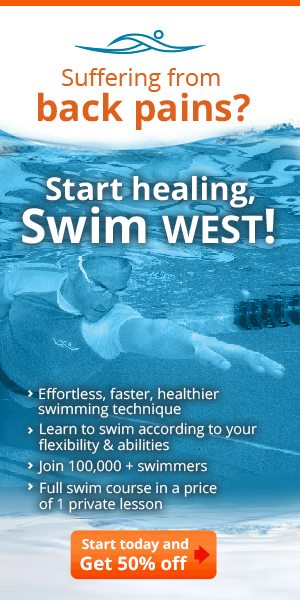Why do swimmers especially triathletes and runners sink in the water?
How to make your legs float in the water when swimming freestyle?
Because of the pressure on the legs and lack of flexibility, you can sink in the water and when you sink in the water you have to work harder with your legs, and if you work harder with your legs, you run out of oxygen, and if you run out of oxygen your movements become faster, you swim more strokes per lap and then you get exhausted very fast.
The most important thing to protect the neck and lower back is to try to stay neutral with the body in the water, which means, the head looking down and the heels are very close to the water surface. This is the best position to swim faster but first, our mission is not to swim faster – but just to float. You probably heard that when you swim you need to blow bubbles when exhaling, and when exhaling you get about 15% more energy and strength, but what happens is when exhaling our legs sink.
We should swim in the right swimming technique in order to float better, and if possible to learn swimming online with the right swimming workout for you.
So in this article we’re going to give you 5 tips to help you float better in the water.
- Stay with your air in your lungs: Don’t release the bubbles and leave your air in your lungs, until you need to exhale before breathing again. What should help you float much better even if you won’t get 15% stronger for a strong pull, because when your legs sink, you’ll come to a stop not only with your legs but with your whole body.
- The depth of your head: You should try to stay with the head very neutral – which means, even in life when we nod, we move our heads just a little bit up and down, so this is the range we can move our head in the water too, because when we drop the head too low, we can cause pressure on the neck. If you do see that you sink a little bit, drop the head just a little bit and you’ll see that the legs are floating better. But this is only a way to work, until you feel better and stronger, so that later you can take your head a little back to the amazing WEST neutral position.
- Palm – we should try to be as loose and released as possible, even in an arched shape, which means we are very loose, especially above the water. When we are tense, and we close the palm above the water – we sink even more, so the looser we are, the easier it will be to float.
- Glide longer – the slower you glide, especially at the end of each stroke, when the shoulder touches the cheek or the chin, that’s the time you might feel a little pressure and that is the exact time you need to glide even longer, because a longer muscle floats better, needs less oxygen and lets you swim above the water and swim faster.
- Depth of the glide – usually competitive swimmers glide very close to the surface of the water, if we are very flexible we should glide about 20 cm, if not we should glide even deeper and deeper in the water because the deeper we stretch the hand, the more our legs float.
When you see you start floating, start changing the swimming technique more and more to elongate your core and your muscles.
If you want to learn more, start the WEST program and learn how YOU should be doing it all right according to your body’s flexibility level.
Swim WEST and you won’t imagine how much you will learn about swimming and about your body.
Why sink? Swim WEST and start floating



